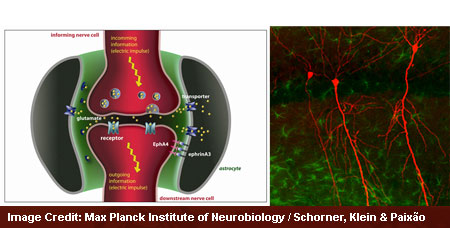Every movement and every thought apparently need the passing of particular information between networks of nerve cells. If an individual wants to improve a skill or be trained in something new then it supposedly involves a larger number of cell contacts. This information exchange could be controlled by certain cells in the brain i.e. the astrocytes. This was claimed by researchers from Max Planck Institute of Neurobiology in Martinsried along with an international team of researchers.
Until now, astrocytes were apparently believed to have their major part in the growth and nourishment of the brain’s nerve cells. The new results apparently develop our knowledge of how the brain learns and remembers. In humans, most abilities that one acquires may be based on what one learns through practice and experience. Thus an individual may be able to carry out both fundamental processes like walking and speaking and may also master difficult jobs like logical reasoning and social interactions.
If an individual wants to learn a new thing, nerve cells may develop new relations or support existing contact points. At such contact points, the synapses, information may be approved from one cell to the next. If one has to develop an acquired ability through practice, it may be possible by strengthening the synapses implicated. Incoming information may bring out a much stronger reaction in the downstream nerve cell when passing through a strengthened synapse, as opposed to a ‘normal’ synapse.
At the cellular level, this could be predicted in many ways. At a synapse, the two conversing nerve cells apparently do not come in direct contact but appear to be alienated by a minute space. When incoming information apparently arrives at the synapse, glutamate may be released into the gap. These transmitter molecules may cross the space and could attach to special receptors in the downstream nerve cell. The downstream cell may be prompted to pass on the information. In a strengthened synapse, the informing cell may discharge more glutamate into the synaptic gap, informing the cell to be more competent at fastening the glutamate. Due to this, information transmission may be considerably improved.
In the brain, parts of nerve cells and single synapses may frequently be surrounded by star-shaped cells namely the astrocytes. So far, astrocytes were primarily thought to assist nerve cells. It is apparently seen that astrocytes may have a much more active part in the brain. They may affect the synapses’ capability to apparently strengthen, and therefore assist in facilitating the learning process.
Ruediger Klein, the supervisor of the research, commented, “These transporters are somewhat like small vacuum cleaners. They suck surplus glutamate from the gap, which prevents, for example, glutamate spilling over from one synapse to the next.”
It is now apparently known to the scientists that astrocyte and downstream nerve cell could converse with each other and thus may adjust the amount of glutamate-eliminating transporters. This interaction was apparently discovered while the neurobiologists were busy probing the signaling molecule ephrinA3 and its requisite partner EphA4 in mice. Ephrins and Eph-receptors may be frequently caught up when cells apparently identify or influence each other.
It was discovered that if a nerve cell is apparently lacking the EphA4-receptor, the adjoining astrocyte may raise its transporter numbers. The superabundant transporters apparently get rid of so much glutamate from the synapse that its strengthening may become unfeasible, a supposed drawback for the capability to learn.
If the signaling molecule ephrinA3 was lacking in an astrocyte, a synaptic strengthening may be damaged due to the need of glutamate, just what took place when EphA4 was supposedly absent. In contrast, if ephrinA3 may be experimentally raised, the amount of astrocyte-transporters could decrease. As a result, glutamate collected in the synaptic gap which in turn may rapidly lead to cell damages and failure of the affected synapses.
The objective of the researchers is to apparently comprehend the transporters’ function in a better way. A significant job, as malfunctioning of the astrocyte transporters may be identified to play a part in neurological and neurodegenerative diseases like epilepsy and the amyotrophic lateral sclerosis (ALS).
This research was published in Nature Neuroscience.

